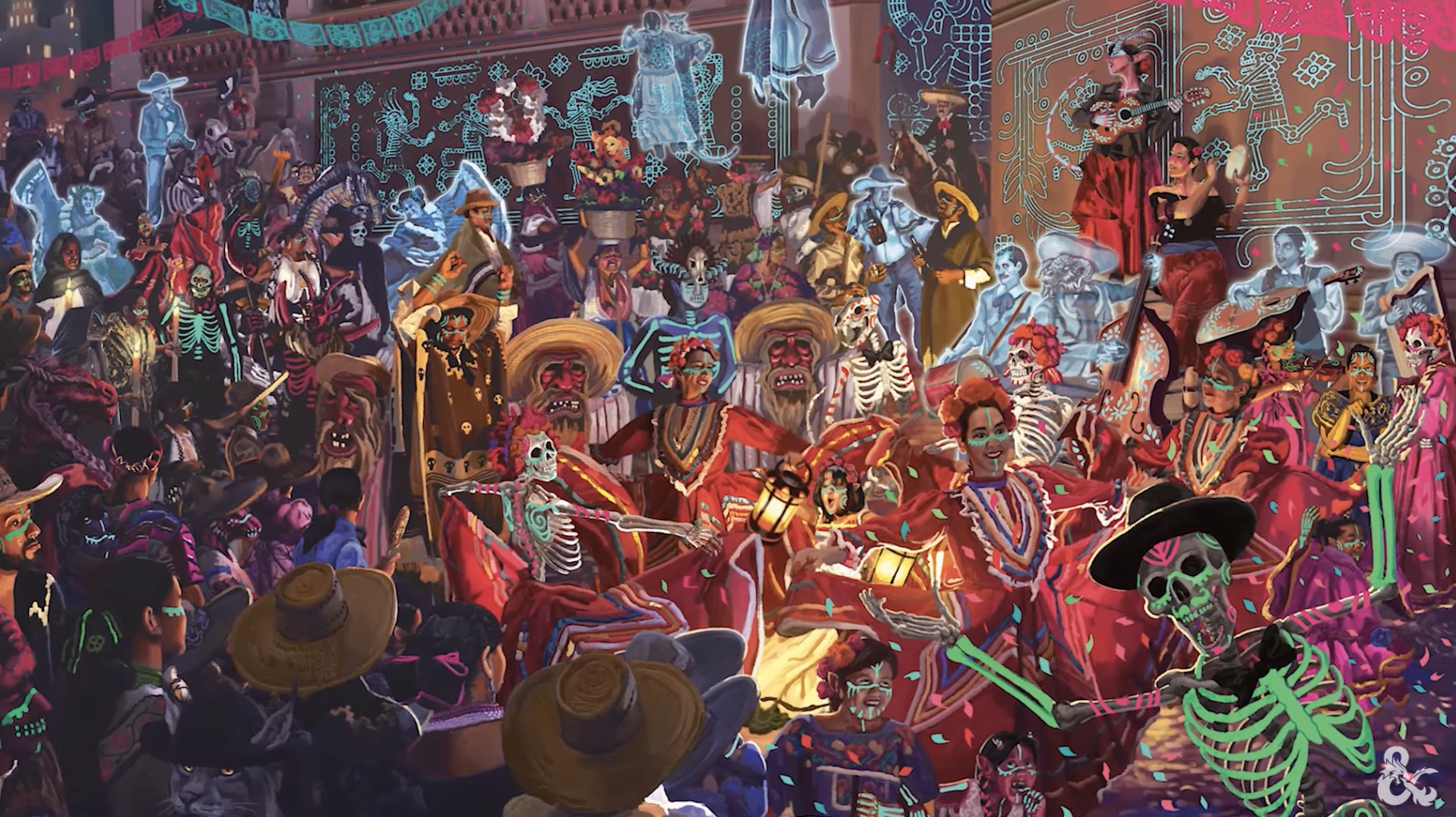We peered, poked, squinted, flipped, and enhanced the teaser image that WotC put out last week, and it turns out we got it right -- the next book is, indeed, Journeys Through the Radiant Citadel.

Wraparound cover art by Evyn Fong
Slated for June 21st (update - I just got a press release which says it's June 21st "in North American stores"; I'm not sure what that means for the rest of us!), it's a 224-page adventure anthology featuring a floating city called the Radiant Citadel. The book is written entirely by people of colour, including Ajit George, who was the first person of Indian heritage to write Indian-inspired material for D&D (in Van Richten's Guide to Ravenloft). Around 50 POC writers were involved in total in various ways.
The Radiant Citadel is on the ethereal plane and is carved from the giant fossil of an unknown monster. A massive gemstone called the Royal Diamond sits at the core, surrounded by a bunch of smaller Concord Jewels, which are gateways to the Citadel's founding civilizations. DMs can link any world to the citadel by placing a Concord Jewel there.
The Citadel, unlike many D&D locations, is more of a sanctuary than a place of danger. The book's alternate cover features a Dawn Incarnate, a creature which is the embodiment of stories and cultures.

 www.enworld.org
www.enworld.org
The adventures are as follows:

Regular cover by Even Fong

Alternate Cover by Sija Hong
Wraparound cover art by Evyn Fong
Through the mists of the Ethereal Plane shines the Radiant Citadel. Travelers from across the multiverse flock to this mysterious bastion to share their traditions, stories, and calls for heroes. A crossroads of wonders and adventures, the Radiant Citadel is the first step on the path to legend. Where will your journeys take you?
Journeys through the Radiant Citadel is a collection of thirteen short, stand-alone D&D adventures featuring challenges for character levels 1–14. Each adventure has ties to the Radiant Citadel, a magical city with connections to lands rich with excitement and danger, and each can be run by itself or as part of an ongoing campaign. Explore this rich and varied collection of adventures in magical lands.
Journeys through the Radiant Citadel is a collection of thirteen short, stand-alone D&D adventures featuring challenges for character levels 1–14. Each adventure has ties to the Radiant Citadel, a magical city with connections to lands rich with excitement and danger, and each can be run by itself or as part of an ongoing campaign. Explore this rich and varied collection of adventures in magical lands.
- Thirteen new stand-alone adventures spanning levels 1 to 14, each with its own set of maps
- Introduces the Radiant Citadel, a new location on the Ethereal Plane that connects adventurers to richly detailed and distinct corners of the D&D multiverse
- Each adventure can be set in any existing D&D campaign setting or on worlds of your own design
- Introduces eleven new D&D monsters
- There’s a story for every adventuring party, from whimsical and light to dark and foreboding and everything in between
Slated for June 21st (update - I just got a press release which says it's June 21st "in North American stores"; I'm not sure what that means for the rest of us!), it's a 224-page adventure anthology featuring a floating city called the Radiant Citadel. The book is written entirely by people of colour, including Ajit George, who was the first person of Indian heritage to write Indian-inspired material for D&D (in Van Richten's Guide to Ravenloft). Around 50 POC writers were involved in total in various ways.
The Radiant Citadel is on the ethereal plane and is carved from the giant fossil of an unknown monster. A massive gemstone called the Royal Diamond sits at the core, surrounded by a bunch of smaller Concord Jewels, which are gateways to the Citadel's founding civilizations. DMs can link any world to the citadel by placing a Concord Jewel there.
The Citadel, unlike many D&D locations, is more of a sanctuary than a place of danger. The book's alternate cover features a Dawn Incarnate, a creature which is the embodiment of stories and cultures.

D&D 5E - Here's Radiant Citadel's press release
Dropped in my inbox a short while ago, if you want the official announcement. It's the same info as in the news article on the front page. Dungeons & Dragons Invites You to Explore the Radiant Citadel Journeys Through the Radiant Citadel is a new collection of short adventures set in wondrous...
 www.enworld.org
www.enworld.org
The adventures are as follows:
- Salted Legacy
- Written In Blood
- The Fiend of Hollow Mine
- Wages of Vice
- Sins of Our Elders
- Gold for Fools and Princes
- Trail of Destruction
- In the Mists of Manivarsha
- Between Tangled Roots
- Shadow of the Sun
- The Nightsea’s Succor
- Buried Dynasty
- Orchids of the Invisible Mountain
Regular cover by Even Fong
Alternate Cover by Sija Hong



